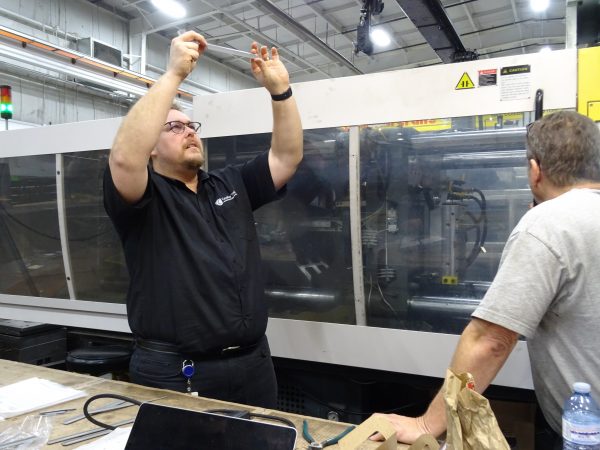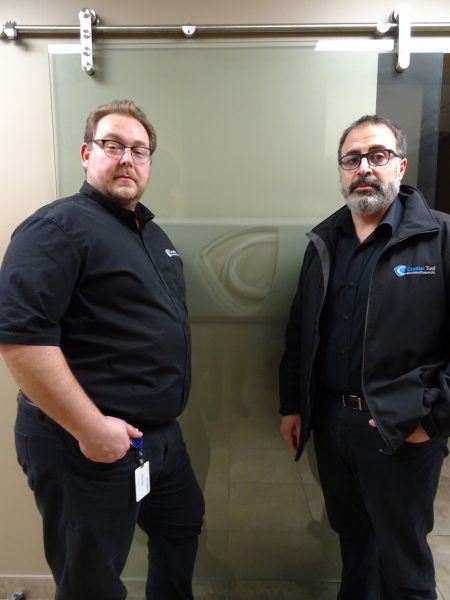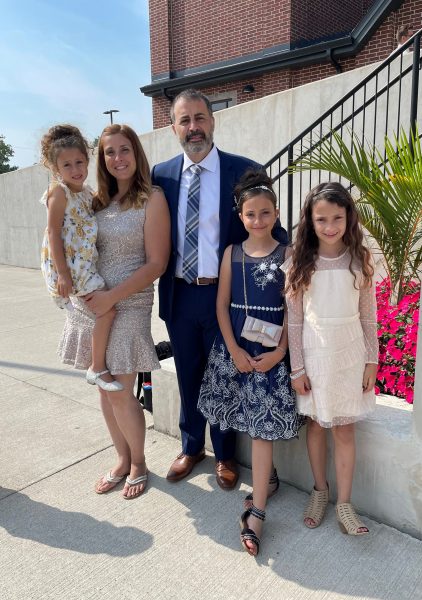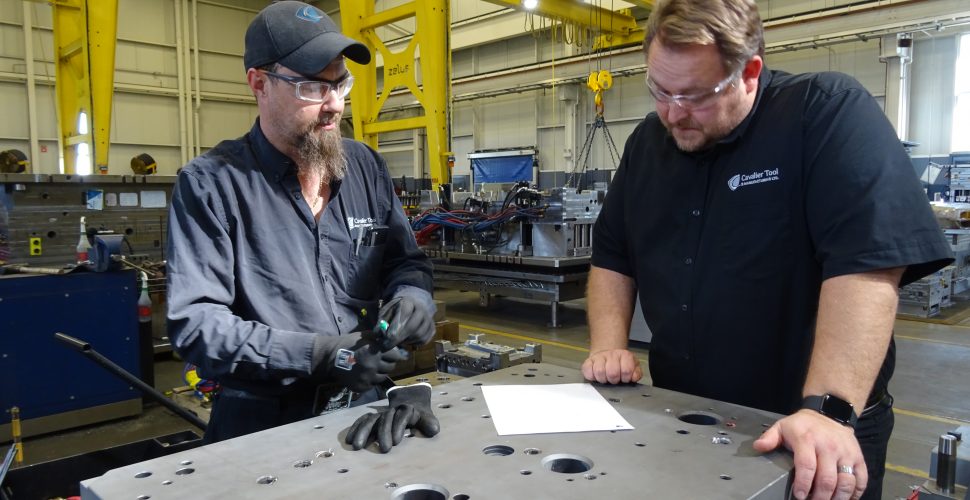
Day in the Life of a Program Manager
Published Mar 24, 2023 | Posted in Cavalier, Industry, News, Technology
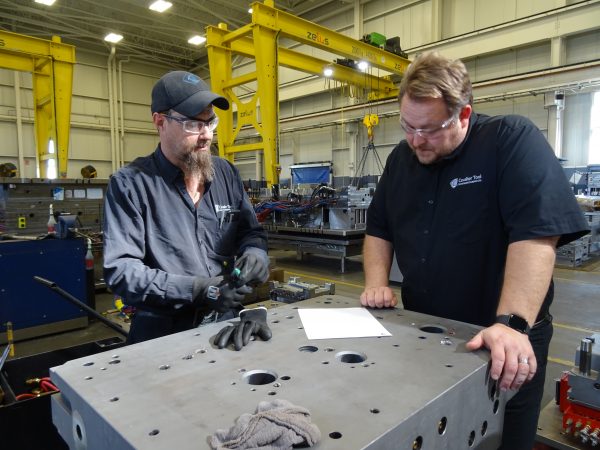
Brian and Jim Black looking over the drawings of a mold in the final stages of completion. |
| A program manager is the crossroads of information in the day-to-day business activities of a mold manufacturer. All information pertaining to a project goes through them.
All Cavalier PMs came from the shop floor, often starting as apprentices and moving their way up from designing tools to managing them. They are fully conversant in CAD software and understand the anatomy of a tool. If required, they can pitch in and help assemble/disassemble and troubleshoot tools. The responsibility of the PM is to guide the job through the various stages of build from initial design until the tool is running production at the customer’s plant. A PM is the direct contact for the customer to give and get information during the build process and is also the resource person to answer questions and advise direction to the Engineering and Manufacturing departments. They monitor milestones of the build process to ensure on-time delivery is achieved. The Program Manager plays the role of the Concierge at Cavalier Tool & Manufacturing. These people are the ones who manage the experience of our customers and take care of all the little details, anticipate problems, work with other members of the team to find solutions and are the key figures in communication with all the steps in the tool making process. This article features Brian Remillong and Steve Debono, both important members of our All Star Team of Program Managers. Let’s hear from ‘Remi’. Tell us how you get to be a PM. Remi started in the business at the tender age of 17, in 1999. His first job was at Quality Model, then he moved to Windsor Mold where he did his apprenticeship. Next up was Platinum Tool Technologies, followed by Toolplas as a Tool Maker where he moved from the shop floor up to the position of Estimating Manager and then on to become a Program manager. Remi joined the Cavalier Army in 2021. Tell me about how a new tool first gets to you? There is a handoff meeting between Estimating and Program Management and oftentimes the Salesperson. A handoff meeting is when the tool information gets passed to the Program Manager. They run through the quote, customer details, intricacies of the schedule, type of commodity and review any oddities. The idea is to get all the background history on what transpired so far with the tool, what the expected margins are, any relevant customer history and who the direct contact person is. |
|||
| What is the first thing you do when you get a job handed to you?
The process at Cavalier is a good one and it is important that we follow it thoroughly. We open up the file that already exists and populate the launch form (TLF). We use information from estimating to fill out as any details as possible. This is when we bring the customer into the loop, we establish rapport, clarify expectations and set the stage for a successful process. We issue the customer the launch form to add any additional information to the job. We would then determine if it is a soft launch or a hard launch. Difference being that a hard launch is ready to run and start. Soft is a little slower, timing has not officially started yet. A soft launch allows us to get ahead in design. If it is a hard launch, we are getting a purchase order, get approved tool data and we start sprinting. |
|||
| What is the difference between new and existing customers?
New customers are always interesting and challenging and it is crucial to establish rapport, clarify standards, and ensure that everyone is on the same page. Existing customers normally you have a good rapport with, most of the time you already know your tooling engineers, design already knows what the customer requests, wants and quirks are. Both are important because we want to make a new customer a future returning customer. |
|||
| How does the diversification at Cavalier impact your job?
We are fortunate at Cavalier that we have a high level of diversification, we work in so many different industries. This impacts us in a positive way. It allows Remi to manage different types of tooling including but not limited to: structural foam, standard injection, rotary tooling, gas counter pressure, water assist, gas assist and more. This is also beneficial to our employees as Remi explains he does not get into a boring routine, the variety really keeps things interesting with all the different tooling requirements. |
|||
| Tell us about the role of Designers?
The role of the design team is critical, they are the first link in the chain of building the tool. It is essential to feed them good information to allow them to produce accurate and clean 3D CAD models. A great deal of communication is required during the design phase, daily conversations with the lead designer as well as the rest of their team. We need to keep things moving quickly and efficiently and often involve increased details from customer. |
|||
| Tell us about the role of CAM and Machinists?
This team is responsible for the programming and operation of CNC, Gundrill, EDM machines. Less interaction is needed here, the key is that the programmers keep the tool rolling along and the operators take care of all the heavy lifting and metal removal. To enhance efficiency, programs are written ahead of time, often times in parallel to allow the machine operators to tackle the day-to-day challenge of ensuring the machines are operating at maximum speeds and feeds. Quality is already assumed by our customers, speed here is an added bonus. Our state of the art equipment and great team of operators allows us to get the tools through the process quicker than most competitors. |
|||
| How do the Tool Makers impact you?
This is a key part of the process as the final assembly of the mold happens at this stage, this phase requires a lot of communication with the tool makers and the customers. For extremely detailed tools with lots of action, we will have a review with mold making to review design, critical steps and any areas that may impact the successful completion of the tool. Mold makers and Program Managers will discuss any showstoppers. The show of course is the tryout!! |
|||
| What about try-outs? What are they and how do they play a role?
The Try-out is the piece de resistance of the process. Here is where we validate all the hard work put into the tool. This is when we literally melt those magic plastic pellets and inject, extrude them or low pressure inject them into the tool. Short of picking up a handful of melted plastic, we get the material in the tool to produce the parts that are needed by our customers. The customers often join us at the Try-out, if not we live feed them in so they are deeply involved in the process. The Try Out stage is so important. Here is Brian analyzing the details. |
|||
| What was the impact of Covid especially considering so many of our customers reside in the United States?
Covid sucks, everyone is tired of talking about it. |
|||
| What makes a successful day for you?
Multiple things here, everyone measures success differently. Successful is little to no firefighting, drama or issues. Other things that happen in a successful day include positive interaction with the customer, positive interaction with other members of the Cavalier Army and ideally learning something new as well. A couple of other good things that I like to see happen include my ability to address any questions put forward, ability to handle issues in a quick and efficient manner and walking out the door knowing that we did good sh&$ today. Finally, hugging his kids when he gets home and talking about work with them so they understand how things get built and how Cavalier helps that process along. |
|||
| How does someone become a PM? | |||
| Remi says that it is essential to have a solid foundation in tool making or design. Need to have good people skills, be comfortable speaking in a group, often in tough situations. One must have the ability to have some hard conversations. Finally, you need to have thick skin. | |||
| “Your skin must be as thick as an elephant, but also oily as a duck for things to roll off your back.” Brian Remillong, Program Manager Cavalier Tool & Manufacturing.
Let’s get some Q&A from Steve Debono Tell us how you get to be a PM A Program Manager needs to be able to navigate a project between the shops needs and the customer needs in order to ensure success for both parties. A PM has to have very good technical skills as well as people skills. The path to becoming a PM usually starts on the shop floor in manufacturing and ideally progresses from there through design and into the front office. My path started in moldmaking and then into design before becoming a PM. My expectations of what the PM role to me prior to starting and what it actually was differed quite a bit. I quickly learned that the key to being successful was how you managed the “grey area” and that normally everyone wants everything right away so it’s a balancing act. Process of the job coming to you first, what happens next? When a project is awarded and after our Sales and Estimating team iron out all the high level details and expectations of job, it’s then handed to the PM. Quote, data, budgets are all provided and a handoff meeting happens. The PM then puts together the engineering launch form information based off the information from estimating and contacts the customer to iron out the final details of the project and its launched to engineering to design. The design process is broken up into stages with the first being the preliminary review. Once design has the concept completed it’s approved internally by the team leaders and presented to the customer for review. The goal out of the first review is to approve concept and ensure the mold will perform in the customers environment. Out of this meeting material is purchase and in most cases 3D cut approval is provided to start rough cut. The second stage of the design is a final review where all of the fine details are completed and reviewed again. The design now has all of the cooling system, ejection and “bells and whistles” ironed out for final review. Some projects require additional stages/reviews depending on the customer/project needs. Once the design process is completed and the job is into manufacturing, the job build plan is put in place and the PM then follows the project though the shop, reporting to the customer on status along the way to completion. Once completed, if nothing changed from the initial launch, the mold is validated and parts are produced and supplied to the customer. The PM will review the part quality with the customer and together determine next steps which could changes, texture, or proceed to final shipment. The PM plays a key role in keeping the project on track and on budget. If the scope of the project changes, it’s the PM’s responsibility to work with the customer to re-align the projects budget. Diversification at Cavalier affect you? At Cavalier we are very fortunate to have ready to build just about any plastic injection mold for any type of project that our customer needs. Diversification keeps the job interesting and challenging at the same time. Different products require different ways of looking at how you manufacture. Working in different industries also allows you to learn and grow your skill sets by working with many different companies that may do things in different ways that you wouldn’t be exposed. Technology at Cavalier Technology is definitely a key to any companies success. You have to “keep up with Jones’” so to speak to be competitive. Our technology allows us the opportunity to do things fast and turn around projects for our customer when they are most in need.
Brian and Steve shown at Cavalier ready to tackle another project. Steve and his lovely family. |
|||

